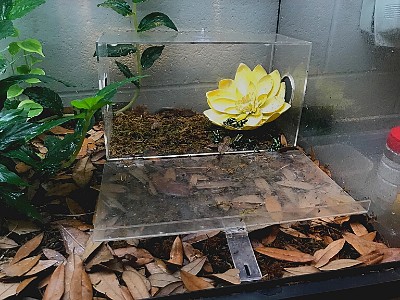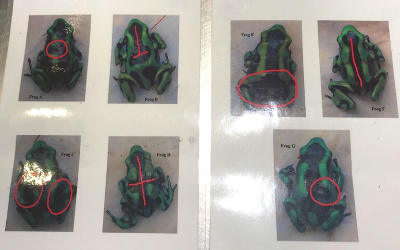Your Akron Zoo is home to many unique animals from around the globe. However, not all of our animals can be seen during a regular visit; some of them live behind the scenes, like our animal ambassadors! Your zoo is home to many ambassador animals, including seven black and green poison dart frogs.
 As animal ambassadors, our poison dart frogs often leave the zoo to participate in education programs and meet and greets throughout Summit County. However, it is not necessary to have all seven frogs for every program. With animal welfare being at the forefront of all our decisions, allowing our animals to make choices serves to reduce stress and should be included in best practices whenever possible. This is why, in April of 2018, keepers devised a plan to station train our frogs with the goal of voluntary participation in kenneling. With this training in place, frogs can choose whether to participate in kenneling and, consequently, whether or not to participate in off-site programs.
As animal ambassadors, our poison dart frogs often leave the zoo to participate in education programs and meet and greets throughout Summit County. However, it is not necessary to have all seven frogs for every program. With animal welfare being at the forefront of all our decisions, allowing our animals to make choices serves to reduce stress and should be included in best practices whenever possible. This is why, in April of 2018, keepers devised a plan to station train our frogs with the goal of voluntary participation in kenneling. With this training in place, frogs can choose whether to participate in kenneling and, consequently, whether or not to participate in off-site programs.
The first step for training was finding a training station for the frogs. We chose a plastic yellow flower because it is large enough for all seven frogs to go to at the same time, and it is mobile so keepers can move the station into a travel case. Its bright color also serves as a visual cue when placed in the kennel for a training session.
To accurately track their participation, keepers needed to be able to identify individual frogs. To do this, we created a chart highlighting each frog’s specific markings. Keepers could track frog training on a spreadsheet, scoring each frog on a scale of one to three. A score of one means the frog remained hidden throughout the training session, two means the frog came out of hiding but did not go completely to the station, and three means the frog successfully stationed at the flower.
In preparation for the training, frogs were encouraged to move to a display container with a gloved hand. Then, for the first step, keepers would click a clicker several times and offer meals of pinhead crickets or wingless fruit flies at the flower station. After a few months, once the frogs learned the connection between the sound of the clicker and the presence of food at the flower, the station was moved to a travel kennel that was established within their larger home. For several months, the frogs were fed and kenneled twice a day, every day. Four of the frogs stationed more than 60% of the time. The least consistent frog participated only 28% of the time.
 After looking more closely at our data, we realized the frogs were more likely to station on fruit fly feeding days. Starting in February 2019 we only asked the frogs to station for
After looking more closely at our data, we realized the frogs were more likely to station on fruit fly feeding days. Starting in February 2019 we only asked the frogs to station for
fruit flies. Using their preferred food item for training made a big difference. As of September of 2019, the least consistent frog comes to the station 61% of the time, with the best frog stationing 85% of the time.
In March of 2019, the frog home was also updated to be bioactive. Their home up until this point had minimal plants and a few coconut hides that were easy to lift and locate frogs for their daily census. The new bioactive home contained many new hiding locations, so their participation in training became even more important to keeping staff. Having additional hiding locations did have a small impact on training immediately after the switch. Frog “D” had the biggest participation change, dropping 6% the month after the move. However, after six months of data, the best frog still kennels 85% of the time.
After switching to the bioactive home, it was also noted that frogs were visible for 88% of the training sessions. This improvement is significant for two reasons. Firstly, the frogs are more active in their new habitat, possibly due to more appropriate humidity. Secondly, the frogs are more likely to participate in kenneling sessions, even with additional hiding spots available.
This training not only allows our animals to have a choice in their day; it also fits well into our messaging as a zoo to foster empathy. Educators can talk about adaptations and ecosystems, as well as how animals learn and their individual behaviors. During programs, our guests are continually impressed when they find out the frogs go into the kennel on their own, and they leave with a greater connection than simply seeing them in a display!
Thank you for your continued support of the Akron Zoo! Click here to learn more about our education programs and how you can meet our poison dart frog, or any of our other animal ambassadors. We hope to see you soon!
